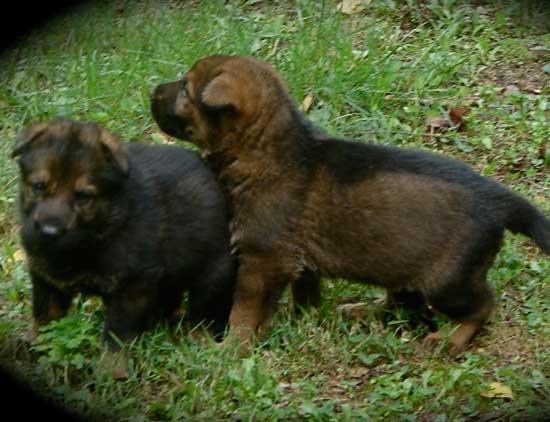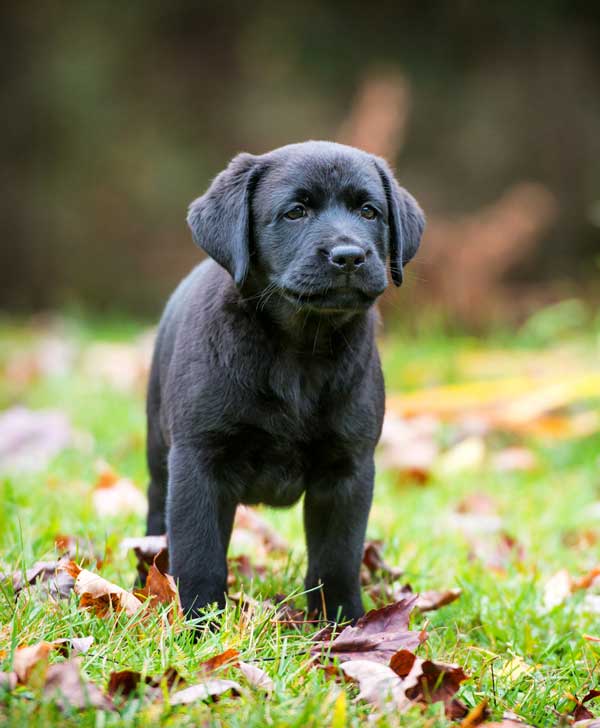Puppy Kindergarten Training Class
by Ellen Landauer
A puppy kindergarten training class is an important positive experience in which we should all participate, so our dogs will grow up to be well-trained and well socialized.
That is what we are told.
Below, CHAPTER 30, 'The Puppy Kindergarten Training Class from Hell,' in 'Hunting for Heart' offers some perspective on the matter.
Here is a tour of a typical socialization and beginning obedience scenario. Except this time, we see it with new eyes and heart.

PHOTO CREDIT:
Constance Krebs, Spartanville Shepherds
Puppy Kindergarten Class from Hell
'The Puppy Kindergarten Training Class
From Hell'
A new puppy is coming into my life in less than two months! Puppy Kindergarten Class from Hell
With joyful anticipation, I await Richard’s call announcing the birth of the puppies. I sense that raising a dog this strong will require some personal growth on my part, so I fasten my seat belt and get ready for the ride.
As open to a new paradigm as I am, the old conventional dog training mentality still has its hooks in me. Therefore, I think my new puppy should be 'socialized.' I dutifully go about looking for a puppy class to fulfill this hallowed purpose.
One weekday evening, I drive to a nearby town to observe classes given by a local AKC (American Kennel Club) dog training group. My main interest is simply to find a class with a nice atmosphere in which to socialize my new pup. I know I will train with Kevin, so the training part of the class must promote happy confidence in the pups for me to even consider signing up.
I have been assured over the phone that the approach used in the puppy kindergarten classes is gentle, kindly, and motivational, not at all repressive or confrontational. In my mind's eye, I fantasize a calm, spacious, pastoral scene with vibrantly happy, gloriously healthy puppies enjoying mock battles - tumbling about in soft, green grass under the benevolent gaze of a compassionate teacher. Delusional New Age ideas of a perfect world full of butterflies and flowers persist despite my first steps on the path to recovery.
As I enter the fortresslike armory building in which the classes are held, my idealized vision of puppy heaven fades under the harsh glare of bare-bulbed lights. In a huge, poured concrete room the size of an airplane hangar, at least a half-dozen classes for various age dogs are about to begin.
I cannot imagine any dog liking the nightmarish din, the hollow vibrations of human and canine voices crashing into one another. I give the environment a D-minus.
In a far, dim corner, enclosed by wire gates, is the puppy class. A cramped space about ten by fourteen feet is lined with folding chairs occupied by the puppy owners. There is about an eight by twelve foot area for eight or nine puppies to play. The puppies range in age from eight to fifteen weeks.
It is play time. The more brazen pups race about in a frenetic whirlwind of activity. Biting each other’s necks, backs, ears and tails, they growl and bark, slamming about the enclosure like a traveling World Federation Wrestling show. Some less confident pups shiver fearfully under chairs behind owners’ legs, barking defensively when their more outgoing classmates come too close.
In the small, compressed space, the movement of the pups is full of rigidity and tension. Their style of play is irritable, snappy, and growly. The large outdoor area I had imagined provided plenty of room for the pups to run, and would have allowed a more free-flowing play session.
As I approach, a sturdy male black lab and a shiny, muscular black and tan terrier mix are sparring noisily. They appear to be around thirteen weeks old and the boldest of the lot. A chubby male Golden Retriever follows them around, barking non-stop in their faces, and at every other pup he comes near, as loudly as possible. However, when presented with the chance for real contact, he backs away.
A nearly four-month-old female Airedale, taller than all the other pups, gently investigates her classmates. The paper tiger of the group is a very disjointed-looking four-month-old male German Shepherd. Sadly, I note that even at such a young age, his joints are over-angulated and collapsing - likely the result of a breeding from American 'show' lines. Even more sadly, his temperament reflects his physiology. He has targeted the shyest pup for most of his social interaction, a female spaniel securely ensconced behind the rungs of her owner’s chair. The Shepherd barks in her face at regular intervals, but backs off from any physical contact with either pups or humans.
'The Puppy Kindergarten Training Class
From Hell' - Youngest Pup

The youngest, a Rottweiler, sits between the feet of his owner, a teenage boy. This pup cannot be more than eight weeks old. His cuteness and the emotional openness in his eyes instantly capture my heart. He sports a velvet soft black and rust coat. Wrinkles around his expressive face remind me of the skin of an infant. New and pure like a flower bud opening, his innocence speaks of the myriad possibilities and untapped potential of an unspoiled temperament.
The Rottie looks as though he wants to join the playing, but appears overwhelmed and frightened by the raucous antics of the older pups. Puppy kindergarten class from hell
I stand at the entrance to the puppy training area, waiting to see who is the instructor, so I can ask permission to come in and observe the class. My heart sinks when I see that the woman who runs the class does not appear much more cheerful than the building in which it is held. Short and stout, with grey hair and sallow complexion, she seems devoid of the exuberance and aliveness that characterizes many of her canine pupils. Without a smile, she lets me enter the enclosure. I take an empty chair next to the youth with the Rottweiler.
As the instructor begins talking to the group, the two rowdiest puppies, locked in an ecstatic bite-fest, suddenly crash into the little Rottweiler. The Rottie screams and ki-yiys, obviously quite shaken up. His owner protectively scoops the baby pup into his arms, trying to soothe him.
The youngest pup has just been traumatized. There is no reaction from the trainer or any of the people in the class. I wonder if the Rottie pup will become aggressive to other dogs later on, as a result of stress attributed to creatures of his own species
The first training exercise is a ‘recall.’ Each owner, in turn, is instructed to call his or her pup while the free play continues. The owner loudly and repeatedly calls their pup's name as the youngsters are having the time of their lives or else overwhelmed by stress. When the pup finally comes, the owner is to grab the pup’s collar and restrain them while giving a treat. It looks like a great way of training pups not to listen!
The most outgoing puppies take the longest to come, after hearing their names repeated over and over again ever more loudly. Once they swallow their treats, they writhe discontentedly, straining to get free.
With the two wildest puppies still slamming about, the trainer asks the Rottie’s owner to leave his chair and call his pup across the play space. I feel the stress building up in the little fellow. He wants to be with his owner, but the older pups are still pounding each other in a mock brawl right in front of him. The Rottie’s eyes get wider, filled with longing and fear, so shiny it looks almost as though they are filled with tears. His body sways forward and back with conflict. I feel badly for him. It feels wrong to put him under acute stress, especially at such a tender age.
I speak up. “He’s really frightened.”
But the loud growling of the playing pups drowns me out. The teacher either does not hear or chooses to ignore me. No one else seems to care. The unconcerned expressions on the faces of the other puppy owners suggest that they think this is just another necessary ‘learning experience.’
The Rottweiler manages to slither around the outside of the circle, slinking under chairs and behind peoples’ feet, until he gets to his owner. Thrilled to be near his person, he sits with perfect form right in front, looking up eagerly in the most innocent, open, adoring way to get his treat. The trainer calls for a round of applause from the group for such a great effort. Does that make up for the acute stress this pup has just stored in his body? I have already decided not to subject my puppy to such insensitive training practices! But there’s more....
'The Puppy Kindergarten Class from Hell'
Teaching Puppies to Stop Biting
The next subject is puppies biting humans. The instructor explains that biting is a normal, innocent puppy behavior. She speaks as though she is on the pup’s side, telling the group that she will show them a 'natural' way of teaching the pup not to bite. The trainer says this method will be perfectly understood by the pup and therefore is the kindest method.
In a more severe tone, she warns how dangerously strong a grown dog’s jaws are, “particularly breeds like terriers,” she says, pointing at the fluffy Airedale, who blinks at us demurely from under bushy eyebrows.
“Mouthing is OK, but hard biting is not, and the way to get the puppy to stop biting is to say ‘Owww.’ That tells them they’re hurting you and makes them stop biting.”
So far, so good.
The trainer asks for a demo dog, "Anyone here having a problem with puppy biting?"
"Oh, yes," the owners exclaim, as the black male Lab is offered up for sacrifice.
“You gotta set ‘em up,” the trainer emphasizes.
She kneels, holding the perplexed pup tightly around the neck with her left arm, stuffing her right hand into his mouth. Shaking him as one would vibrate a jammed wind-up toy to make it start, she goads him. “C’mon, you gonna bite me?”
The humans in the class are gazing at the instructor like she's a hero.
The pup starts lightly mouthing her in a very hesitant, uninspired way that couldn’t possibly be causing her any discomfort. After five seconds, the instructor puts her face inches from his right ear and bellows, “AHHHAOOWWW!”
A cow tangled in a barbed-wire fence would make a more agreeable sound! This is not a yelp that says, ‘Ouch, you hurt me.’ It is a thunderclap that the pup hears as, ‘I’m gonna KILL you!’
The pup quits biting, tilts his nose up, and starts nervously licking the instructor’s chin. She smiles smugly and says, “See?”
Everyone but me is looking at her like she’s a genius. ‘Yes, yes, see how he behaves now! She showed him that he did something wrong. He feels guilty and now he’s apologizing. How wonderful!’
Of course, the trainer must go on and ‘set him up’ again, training him by repetition so he learns it better. After the second time of having her roar in his tender little ear like a rampaging bull moose, the beleaguered Black Lab pup starts chewing on his leash and won’t stop.
The instructor lifts the leash out of his reach and does a third go-round. She will make sure he never forgets this lesson (he won’t).
After his brain is fried for the third time, the pup goes into an apoplectic frenzy, scratching and chewing on the rubber floor mats of the training area, lifting them up by the edges, trying to get under them, trying to rip them to pieces. He falls down on the slippery floor under the mats, swimming as he tries to regain his footing. Discordant, spastic movements bespeak a new level of panic and desperation. Panting at top speed, he flails about on the floor as though in the grip of a grand mal epileptic seizure, eyes rolling, lips drawn back, gums exposed, tongue flapping about.
The trainer repeatedly tries to interrupt his hysteria by putting her hands around his sides. But every time she stops restraining him, the Black Lab goes right back to desperately trying to dig his way to China as soon as he is able to move his solid little body again. Anything to escape this living Hell!
The instructor appears perturbed. This could make her look bad! Her next words demonstrate that she cannot possibly understand why this puppy now behaves like a raving lunatic.
Addressing the pup, she uses some humor to discredit him. “Hey you - you don’t think there’s a CAT under there, do you?” (Translation - ‘It’s not my fault; this puppy is certifiably crazy!)'.
Getting nowhere by talking to the terror-stricken canine, the instructor stands up, lifting him off the mats. She casually holds him dangling from her hip like a wilted sack of potatoes. No one seems to notice that this restraint is the only way the teacher is able to stop the ‘crazy’ behavior. No one notices that so-called ‘training’ has turned a non-issue into a traumatic event leading to a possible behavior problem! All appear to be clueless about how frightening this has been for the puppy!
All the puppy owners complacently accept the terror of this puppy as normal. Why are they all so silent and compliant? Why am I silent? Is it because I know that it is no use to say anything? Is it because I know they would all try to make me wrong? Why don’t they question anything? Why can’t they see what I see, feel what I feel?
The pup’s eyes roll in panic, whites flashing under a pained furrow in his forehead. His lips are drawn back, teeth agape and tongue hanging out as though he is dying. His paws thrash about desperately as he hangs from the trainer's locked arm, as though to say, ‘Let me the hell out of here; get me away from this horrible lady!’
My jaw hangs in shock, my own brow furrowed in pain. My heart aches. A sinking feeling washes through my gut. The Black Lab puppy that is going home tonight is not the same one his owners brought here an hour ago.

The last subject is getting the puppy not to pull when walking on leash. As the instructor talks, I reach down to the Rottweiler pup, who is curled up, using my foot as a pillow. As I rub his fat little belly, he grunts contentedly, rolling more onto his back, then falls asleep.
Another ‘demo’ puppy is called for. The shiny black and tan terrier strides forward with a swagger as the owner surrenders his leash. With Herculean temperament in a compact body, this boy is ready for a good game.
The Rottweiler’s owner reaches down, grasps his pup suddenly, startling him awake. He plunks the little fellow down in front of him facing outward, saying, “Hey, wake up, you’re supposed to be paying attention.” He seems to believe that his puppy will learn not to pull by watching some other pup get corrected.
The terrier pup has it all figured out, insistently climbing up the trainer’s leg to get at the treats in her pocket. She gives him a treat, then walks him around a bit, trying to get him interested in playing with another puppy. He is more interested in her and the food, tuning out all distractions and giving her his undivided attention.
He is not pulling on the leash at all! He is doing exactly the ideal behavior described by the instructor. That’s not good enough for her!
The instructor does not comment on the fact that the pup is already tuning out all distractions to make sustained contact with her!
She has an agenda. She has to create the problem she claims to solve - to get the puppy to make a ‘mistake.’ That way, she can demonstrate ‘training’ to the group, so that’s what’s going to happen! With rapt attention, everybody waits to see the performance, to see the demonstration of the magic leash yank. Their guru won’t disappoint them!
Eventually, the terrier shows a lukewarm attraction toward another pup. The woman starts giving him the ‘kinder, gentler’ correction for puppies, niggling little tugs on the leash. Everyone is on the edge of their seats, taking it all in so they can remember how to do this to their puppies when they get home.
I watch, fascinated, as the gutsy little firebrand suddenly grows more and more determined to lunge at every blessed thing in his path! Like a wild thing, with every tug the instructor gives him, the terrier pulls away from her harder and faster! His claws rake the floor as he uses every bit of leverage he can muster to keep the lead tight as a drum-head! The trainer calls to him, but now his focus is determinedly off her and onto everyone and everything else. She has accomplished the exact opposite of her stated goal! She just created the problem that she claims to solve! Once again, nobody seems to notice.
Finally, the instructor reels the pup in close and holds a treat right under his nose. That gets him only mildly interested in her, evidenced by the lukewarm manner in which he swallows his morsel. Now she is happy. Never mind that she had to make the pup wrong to prove herself right. Everyone is duly impressed with what a great dog trainer she is. ‘Yes, we must train these puppies who will take advantage of us anytime they get a chance. Can’t let them be too wild - oohhh, nooo!'
I don’t hear the instructor’s parting words of wisdom. It’s been years since I spent any time around conventional dog training. Not much has changed, except for some simpering politically-correct comments about the naturalness of puppy behavior to sugar-coat the same old clueless routine.
On my way out, I stop to observe the adult dog classes. One group is doing heeling exercises in a square pattern; heel, sit, heel, about turn etc. Here revealed are the results of conventional training. Every dog in the group is doing one or more of the following: pulling away from the owner, trying to fight or play with the dog in front or behind them - or plodding along like a zombie having given up any hope of enjoying life.
The awareness that the Dark Ages of dog training are still with us enshrouds me like an oppressive fog. Stuck in a dim corner in this ghoulish echo chamber of a building, pure-hearted puppies sacrifice their aliveness.
The evening from beginning to end has been like a walk through a Dante's Inferno for puppies. The only difference is that the puppies have not committed any sins - that job has unwittingly been accomplished by their owners and trainers.
With perceptions becoming more acute through the beginnings of my study with Kevin, this commonly accepted training/socialization scenario feels like a bad dream. A stranger in a strange land, I walk slowly toward the exit of the armory, past classes for older dogs that are also ending. A sense of relief washes over me as I stride out into the fresh night air with owners and pups.
The late winter air is brisk and bracing. As I descend the long flight of stone steps to the parking lot, gusts of icy wind toss dry leaves and paper cups in a madly spinning dance.
I look forward to the new adventure of finding harmony with the wild heart of a dog.
"The number one mistake puppy owners are making is overly stimulating their puppy, usually by showering it with attention as a measure of their love, and then when they don't like the instincts this triggers, they then set out to teach it how to be social by correcting these instincts." - Kevin Behan
BUY 'Hunting for Heart' and
Rediscover Your Primordial Bond With Dogs
BUY the
Book
HEALTH INFO
FOR YOU
My other website:
Peak health helps you have more energy to enjoy your dog!
